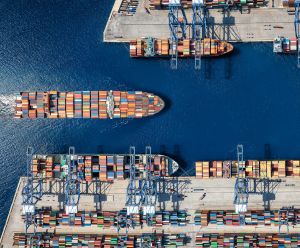
Shippers pause, resume and reroute amid tariff changes

Container lines and shippers are scrambling to adapt to the torrent of tariffs and exemptions unleashed by the White House since ‘Liberation Day’ on 2 April.
In the first week of May, U.S. West Coast ports are already feeling the bite of the trade war. Container shipping volumes arriving from China fell this month, with the key transpacific gateway complex of Los Angeles/Long Beach anticipating a decline of more than a third compared to normal monthly throughput.
Much of the surplus capacity removed from Asia-U.S. trade lanes has been redeployed on Asia-North Europe and Asia-Mediterranean routes, where spot rates have started to slip as a result.
Lanes switching on the tariffs road
However, with baseline tariffs on China now at 30 percent for a 90-day period, m. The sudden tariff reduction will most likely trigger a wave of cargo, waiting at Chinese ports, compete to get on available ships heading to the U.S. in the next two weeks. With no clear indication of whether the tariffs will revert to higher levels, U.S. importers are trying to beat the 14 August deadline as they rush for urgent order fulfilment ahead of the peak season.
For the next three weeks, U.S. ports will continue to see a decline in ships arriving, due to the knock-on effect of the previous blank sailings. However, to anticipate the influx of cargo from China, with limited idle capacity available, carriers will redeploy capacity on the Transpacific lanes. Affected lanes outside of Transpacific routes will face further disruption and rate volatility, creating uncertainty and rate volatility in the months to come.
The impact will be felt further down the road on both ends, as the influx of goods will create a bottleneck at the U.S. ports in four to five weeks. Ports will shift from being half-empty when businesses adopted a wait-and-see strategy, to both U.S. coastal ports overwhelmed by a wave of shipments being scrambled out by companies.
The current trajectory points to an early peak season, one where shippers are scrambling to deal with an increased volume, limited capacity, and disruptions across the board. “In these uncertain times, we take advantage of our expansive global network to provide unparalleled flexibility and tailored solutions. Our diverse carrier portfolio ensures optimal use of available capacity across routes, minimizing the risk of service disruptions,” said Niki Frank, CEO, DHL Global Forwarding Asia Pacific.
Schedule reliability softens the capacity and rates crunch
The bright spot emerging is the upward trend in schedule reliability. In March, analyst firm Sea-Intelligence reported that global schedule reliability improved by 3.0 percentage points month-on-month to 57.5 percent.
It is the highest level recorded since November 2023, with Maersk and Hapag Lloyd, partners in the Gemini Cooperation, being the best performers. The Gemini Cooperation has delivered on improved reliability across February/March, recording 90.3 percent schedule reliability across all arrivals. MSC scored 75.8 percent over the same period. The Premier Alliance notched up 53.2 percent reliability and the Ocean Alliance 54.9 percent. However, Sea-Intelligence also noted that the new alliances will only be fully rolled out in July 2025, and it will only then be possible to truly evaluate their performance.
“Schedule reliability is improving, but it’s not enough to offset the broader uncertainty shippers face right now,” said Praveen Gregory, Senior Vice President, Ocean Freight, DHL Global Forwarding Asia Pacific. "Our role at DHL Global Forwarding is to help clients navigate this new reality. These include providing real-time supply chain visibility via our digital platform myDHLi for tracking and disruption predictions, as well as offering guidance on tariff optimization, including Free Trade Zone utilization and duty drawback solutions.”
While schedule reliability acts as an indicator of whether the shipment arrives on time, it does not include the wave of blank sailings that were introduced. As more ships return to the routes with fully utilized capacities, various factors, such as port dwelling times, which is anticipated to increase with the influx of goods that leads to longer unloading times, will affect overall schedule reliability.
The economic see-saw
The shifting tariffs have undoubtedly had an impact on the retail front. Before the 90-day extension was announced, the National Retail Federation predicted U.S. containerized import volumes could drop by 25 percent in H2 2025. The Christmas peak went under the microscope, with widespread order cancellations already underway as some 80 percent of toys are sourced from China. Those that had suppliers elsewhere were rushing to ship goods during the 90-day moratorium on tariffs for non-China suppliers. This has split the market, with Southeast Asian trade lanes commanding higher rates and volumes compared to China routes.
As DHL's May Ocean Freight Market Update noted earlier in May, global economic forecasts have been downgraded on declining business confidence. The report highlighted that both Drewry and Linerlytica have cut container growth projections to -1 percent in 2025.
The recent rollback of U.S. tariffs on Chinese goods will likely improve the immediate economic outlook for both countries. It is expected to provide a short-term boost to economic growth for China, with analyst firm J.P. Morgan increasing China’s projected growth forecast from 4.1 percent to 4.8 percent. UBS Investment Bank also estimates the tariff change could add approximately 0.4 percent to U.S. GDP growth this year, with a smaller carryover effect into next year.
However, the tariffs remain high by historical standards. Even with the tariffs reduced to 30 percent, the additional cost will hit companies significantly, especially for small business. A myriad of costs will have a knock-on effect on both businesses and consumers as the months persist, with an already clogged pipeline from Chinese ports now being unclogged and potentially building up on the U.S coasts.
Controlled chaos
Businesses remain cautiously optimistic during the 90-day window, which is essentially a negotiation window for the two countries. While it has eased immediate economic pressures, significant uncertainty persists until a long-term trade agreement between China and the U.S. is ironed out before the reprieve expires on 14 August.
As the deadline approaches, companies are reassessing their supply chain structures, including supplier relationships and geographic sourcing strategies, to identify vulnerabilities related to tariffs. The China Plus X narrative is stronger than ever, as more companies are accelerating their supply chain diversification to source products from multiple origins to counter potential tariffs.
“With multiple locations in play, our portfolio of services, including multimodal transportation solutions that combine the advantages of different modes of transport, helps companies to make their supply chains not only efficient, but also future-proof,” noted Frank.
MORE FROM THIS COLLECTION












 English
English